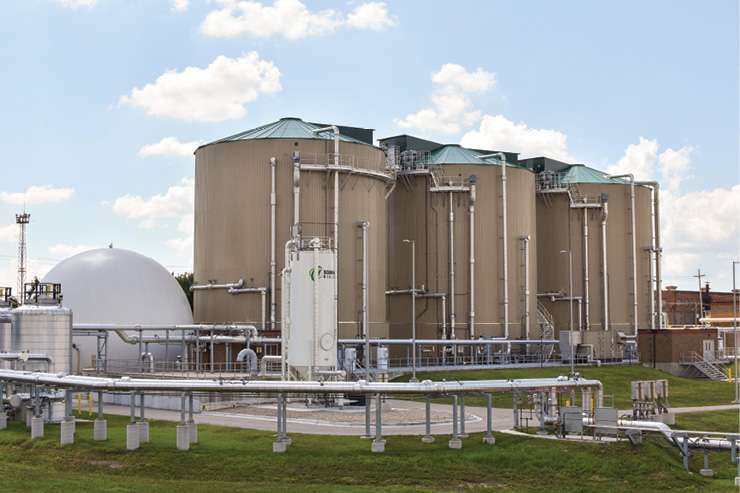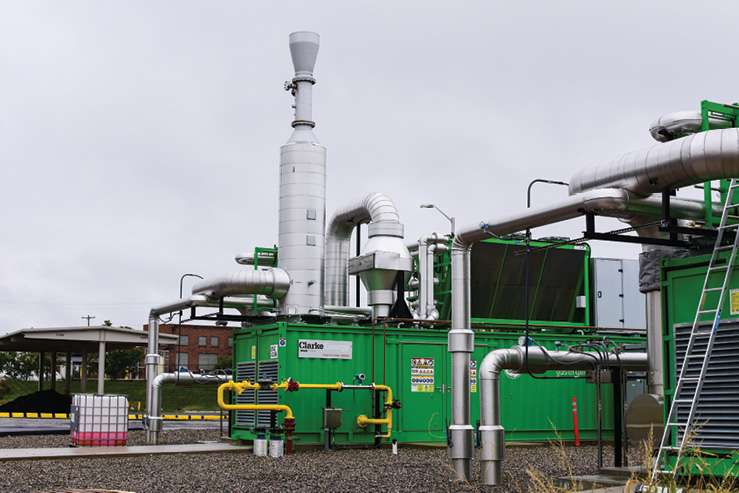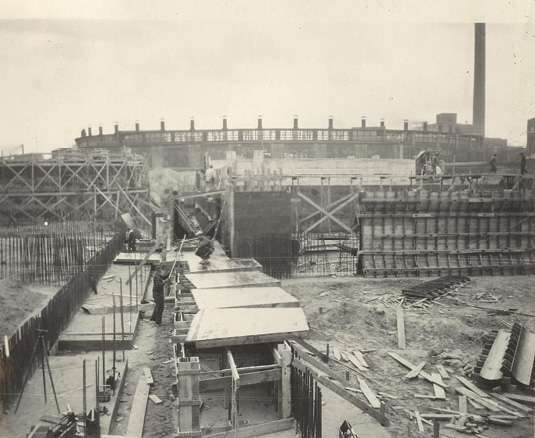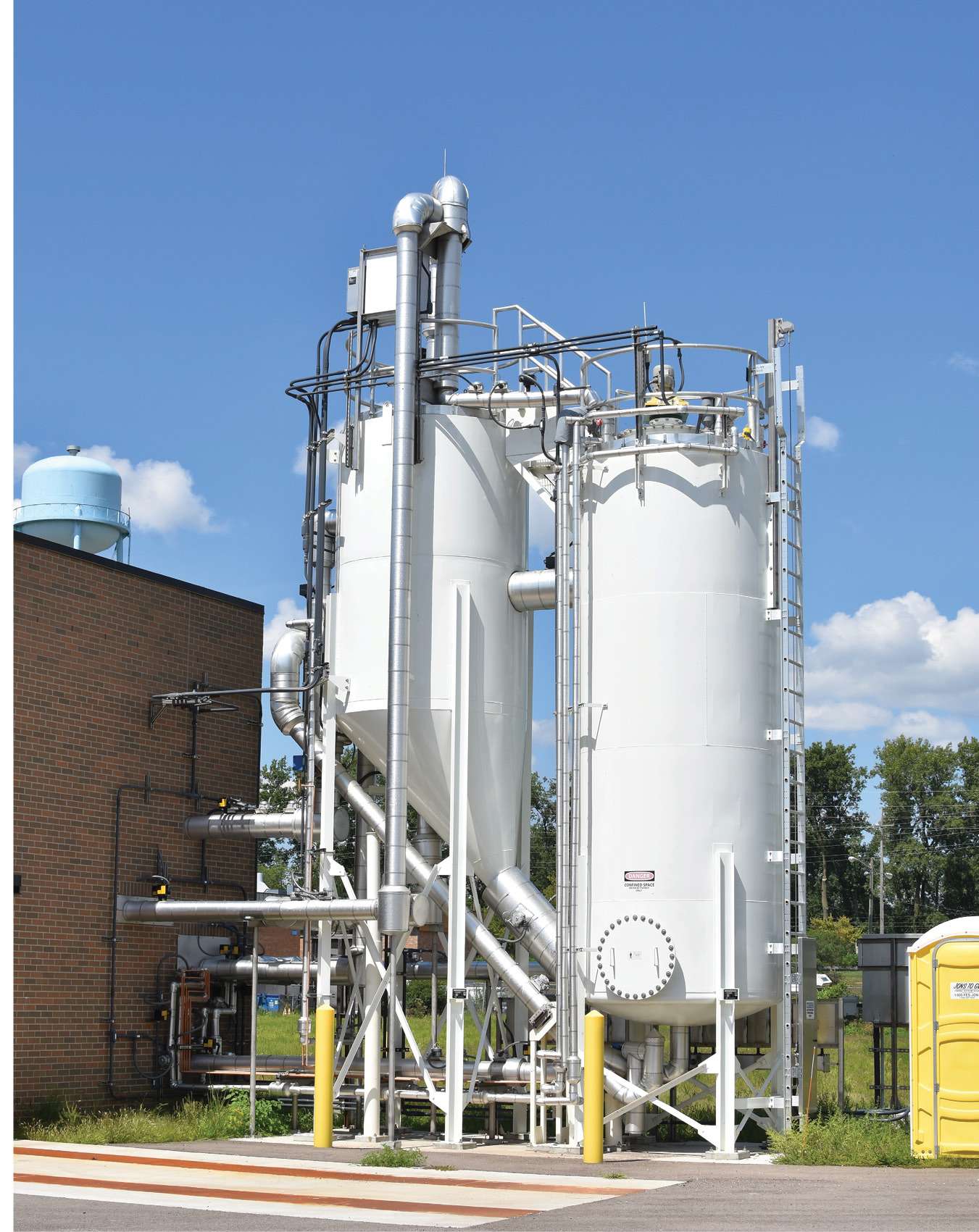New Water Resource Recovery Facility for ‘Beer City USA‘

A Renewable Natural Gas (RNG) conditioning system recovers and conditions methane to pipeline-quality natural gas used by the city of Grand Rapids’ public transportation system and the city’s natural-gas-powered vehicles.
With more than 40 breweries, the city of Grand Rapids, Mich., often has been called “Beer City USA.”
While that distinction put Grand Rapids on the map for locals and tourists alike, it also created a unique wastewater stream that drove the city to open a state-of-the-art, $85 million biodigestion system at its Water Resource Recovery Facility (WRRF) in 2021. The city constructed a concentrated wastewater force main to pump waste directly from the breweries to the WRRF.
Grand Rapids’ WRRF serves a population of 277,030 in Grand Rapids and 11 community partners. The conventional treatment plant has bar screening, grit removal, primary settling and aeration as well as secondary treatment that includes microorganisms, aeration, UV disinfection and final clarifiers before discharging to the Grand River. It has an average flow of 40 million gallons per day (MGD) and a 90 MGD peak flow.
A Long History of Treatment
James Hurt, Grand Rapids’ public services director, notes the plant dates back to Oct. 31, 1930. A combined sewer system delivered waste to the plant where solids were separated out and turned into RapidGro fertilizer that was sold to farmers.
A secondary treatment included in the plant’s original design was delayed for years due to lack of funds. In 1954, the plant finally was expanded to include secondary treatment as well as a new building to house administration and a modern laboratory. By 1976, most of the plant’s aging equipment was updated. Huge Archimedes screw pumps were added to pump effluent water uphill during times when the Grand River level is high.
The growth of industry—especially metal plating finishers—warranted creation of an industrial pretreatment program to keep more than just household waste out of the Grand River. In 2017, a 30-year $400 million sewer-improvement project was completed that eliminated sewer overflows from entering the Grand River.
“Today, Grand Rapids has a separated sewer system so stormwater is the only thing discharged directly into the Grand River,” says Hurt.
New Facility Adds Recycling Capabilities
In 2021, construction was completed of a biodigestion facility that includes three biodigester tanks, each with a capacity of 1.4 million gallons, a Unison Renewable Natural Gas (RNG) gas conditioning system, combined heat and power (CHP), and a phosphorus recovery system.
“By recovering the biogas and upgrading it to pipeline-quality natural gas, we are keeping it out of the atmosphere, reducing our carbon emissions,” says Hurt. “Once the gas is refined, it’s injected into DTE Energy’s pipeline to be used by The Rapid—our public transportation system—and our natural-gas-powered city vehicles.”
In vehicles using RNG instead of conventional fuel, harmful nitrogen-oxide and greenhouse emissions are reduced significantly.
“We’re able to reduce the amount of waste we’re sending to the landfill, fuel our fleet and other fleets with low-carbon and healthier RNG, and the city’s fuel costs are reduced,” explains Hurt. “This effort also supports the city’s goal to reduce our carbon-emissions footprint by 85 percent by 2030.”
The pipeline-quality RNG is sold to the area’s natural gas company for Renewable Natural Gas Credits (D-3 RNS) from the municipal sludge digesters and as a renewable natural gas from the concentrated waste digester. “This revenue is received back into the department and used as part of our rate calculations,” adds Hurt.
The CHP system captures thermal energy normally lost during traditional power generation. “To accomplish this, we installed an interconnection at a power substation located at the front of the facility,” says Hurt. “As a result, two CHP engines produce 2.6 megawatts of energy used to power the water-resource recovery facility.
“When the CHP system produces more energy than we’re consuming, it will automatically switch to sell the power to Consumers Energy’s grid through a parallel switchgear,” he adds. “When we’re not producing enough energy to power the facility, the switchgear will still allow us to source electricity from the grid again. This system can also be used as a backup power source, providing a redundant supply should we ever lose power.”
The heat produced by the CHP engines also is captured and travels to the biodigester, where it keeps the tanks at about 98 degrees Fahrenheit, the optimal temperature inside an anaerobic digester to allow the microorganisms to thrive and digest waste.
“Any excess heat can be pulled out and cooled off by fans located on top of the CHP units, which can be used to cool the engines,” notes Hurt. “This closed-loop heat exchanger essentially works like a radiator.
“The CHP system helps us operate the facility at increased energy efficiency while reducing greenhouse gas emissions,” he continues. “In addition, the CHP system means we don’t need to use boilers, which are typically used to heat digester tanks.”

Three biodigester tanks, each with a capacity of 1.4 million gallons, reduced the city of Grand Rapids’ sludge volume by more than 30 percent.

Two Combined Heating and Power engines produce 2.6 megawatts of energy—enough to power the Grand Rapids Water Resource Recovery Facility while reducing greenhouse gas emissions.

A circular economy is not a new concept in Grand Rapids; a 1930s wastewater-treatment plant separated solids for fertilizer that was sold to farmers.
Resource Recovery
During the conversion of sludge to biogas, phosphorus contained in the organic part of the sludge is released. “We recover the phosphorus by adjusting the pH of the digested biosolids by removing dissolved carbon dioxide,” explains Hurt. “The biosolids are then dewatered by spinning them in a centrifuge. The water produced in this step—called centrate—still contains a high amount of phosphorus and a high pH. The released phosphorus can be recovered and used as a soil fertilizer. This also allows us to eliminate the buildup of struvite and helps to keep phosphates out of the watershed, which can lead to eutrophication. The struvite phosphorus crystals can be sold to the fertilizer industry.”
Environmental concerns were a major driver for the project, notes Mike Grenier, Grand Rapids manager of environmental services. He points out the value of keeping fewer materials out of the landfill and instead repurposing them for other products.
“That gets to the fact that we’re a resource-recovery facility,” he says. “We’re recovering natural gas, scrubbing that up and selling that out of the system as well. We’re pretty proud of this project.”
Lisa Ann Rapp, American Public Works Association board member, liaison to its Center for Sustainability and public works director emeritus at the City of Lakewood, Calif., notes that public works professionals “have long recognized that sustainable management of municipal solid waste is more than just ensuring public health from a sanitation perspective.
“Rather, there is an expectation by the communities we serve to manage these materials as resources in a manner that fully recognizes their value. To accomplish that mission, many public-works agencies have prioritized a waste-to-resource or circular economy model to manage municipal solid waste.”
Traditionally, that has focused on collecting and remanufacturing aluminum cans to save energy and preserve natural resources, says Rapp. Remanufacturing of organic waste materials into compost is another common approach.
“The most-recent and growing segment is to accept larger producers of organic waste, such as the brewing industry and many agricultural industries such as dairies, to utilize waste organics through an anaerobic process to generate renewable natural gas,” she adds. “This renewable gas can substitute for fossil natural gas as a direct substitute to fuel vehicles, heat trucks and power facilities.”

The city of Grand Rapids keeps phosphates out of the watershed by recovering phosphorus during the biogas conversion process and turning it into soil fertilizer.
Financial Concerns
According to Hurt, the project’s RNG portion has a $14 million capital investment with an eight-year ROI estimate. “For the digestion and concentrated waste digesters, ROI is found in not needing to expand the facility as well as reducing the amount of sludge for disposal,” he adds. “Currently, we estimate reducing our sludge volume by more than 30 percent.”
Future plans call for launching a liquid industrial byproduct program. “We’re developing the infrastructure to receive hauled waste from industries,” explains Hurt. “The biodigestion project began in 2017. At this time, a long rest is needed and planned. As we get better at running the new systems, other waste streams will be evaluated to be received, and we will be looking at what other resources we can recover.”
Hurt notes that pulling off a complex project during a global pandemic was challenging.
“On the practical side, you are exposed to the energy markets both for natural gas and electricity,” he adds. “Balancing the risks and rewards of this exposure and the education of your leadership surrounding these issues is important.”
According to Hurt, those considering a similar project are best served by staying focused on its total cost and revenue streams.
“Due to the highly technical nature of the systems involved, significant service contracts were required,” he adds. “As staff become more educated about this equipment, much of this work will be brought back inhouse, but there are costs to account for in your O&M budgets.”
About Carol Brzozowski
Carol Brzozowski is a freelance journalist specializing in technology, resource management and construction topics; email: [email protected].


